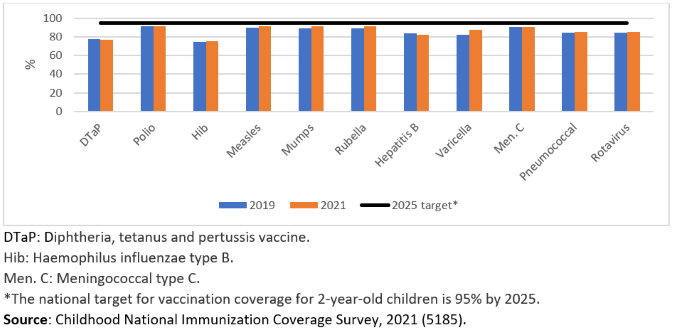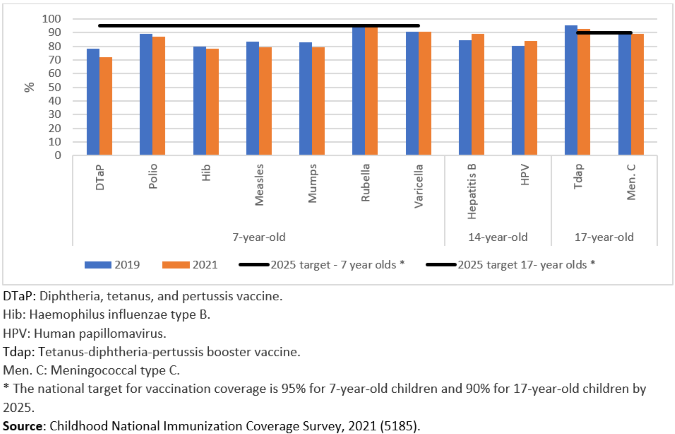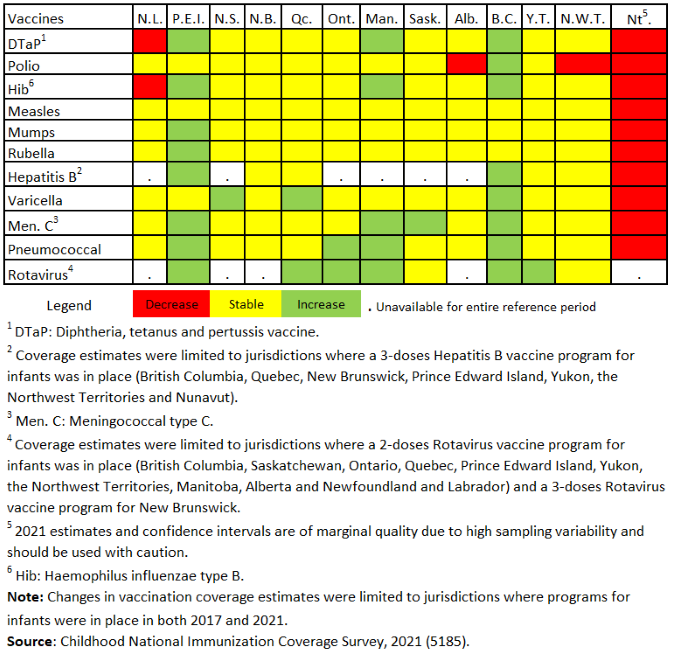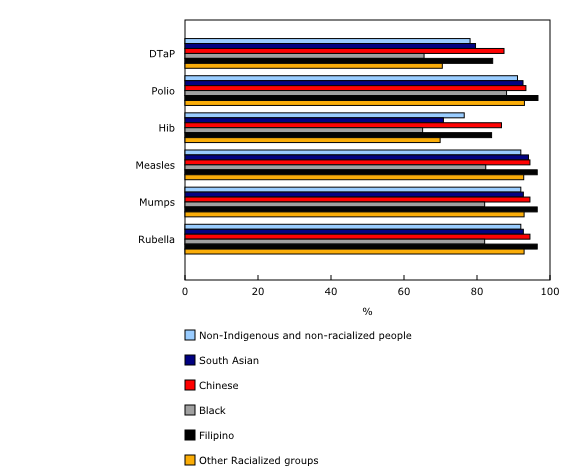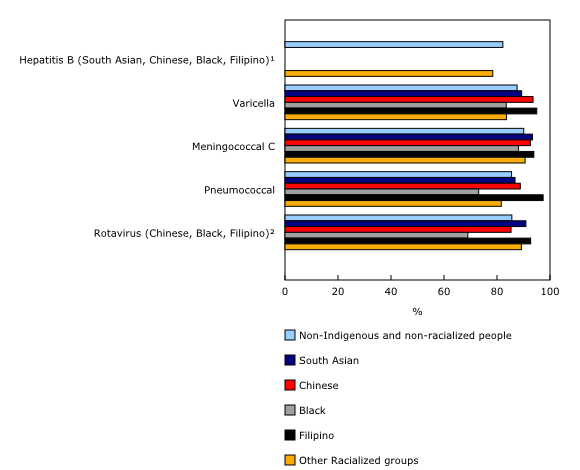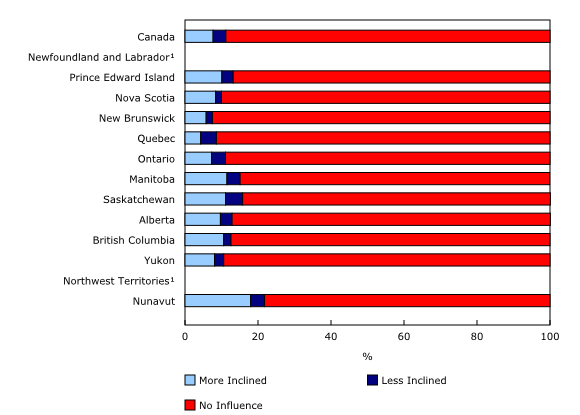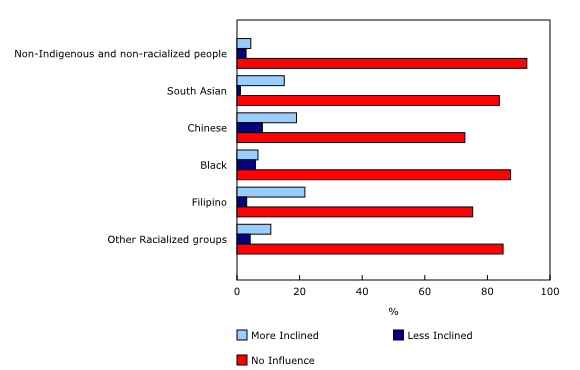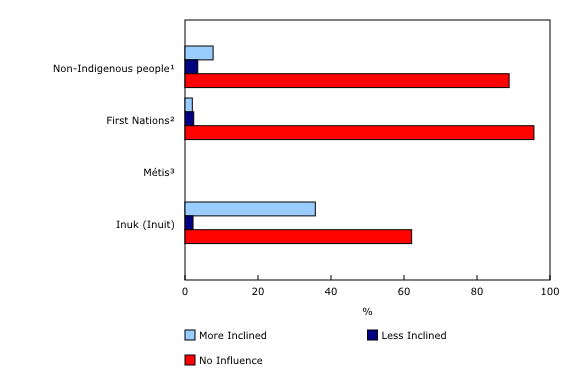Childhood National Immunization Coverage Survey, 2021
Released: 2023-06-12
Routine childhood vaccination is recommended to help prevent and control a variety of diseases in children, including diphtheria, pertussis, measles, tetanus and polio. Vaccines administered to children not only help protect those who are vaccinated, but also those who are unable to be vaccinated. In Canada, routine vaccines recommended by the National Advisory Committee on Immunization are provided to children free of charge as part of provincial and territorial publicly funded programs.
The results published today are from the Childhood National Immunization Coverage Survey (CNICS) collected in 2021, during the COVID-19 pandemic. At the time, Canadians faced many changes to their daily lives. While essential immunizations for children under 2 years of age remained prioritized, in-school vaccination programs for adolescents experienced delays and interruptions that differed across jurisdictions. A comparison with the previous CNICS cycle in 2019, conducted just prior to the pandemic, will help to start quantifying some of the early impacts this historical event may have had on vaccinations and on the knowledge and beliefs of parents and guardians who make decisions about child vaccination. Due to an alternating approach in sampling methodology across cycles, the CNICS 2019 results are the latest available comparator for national level estimates, while the CNICS 2017 results are the latest available comparators for provincial- and territorial-level estimates.
Although CNICS 2021 results show the early impacts of the pandemic seem to have had little influence on national immunization rates in 2021, it is important to note that many children in the target population would have received some or all of their recommended vaccines prior to the onset of the pandemic. Generally, national immunization rates in Canada remained stable across all childhood age groups in 2021 compared with 2019. However, an increased immunization rate against human papillomavirus (HPV) among boys aged 14 years was identified (81% in 2021 compared with 73% in 2019). Most parents and guardians reported either that the pandemic had no influence (80%) or that they were more inclined (18%) to get their child vaccinated. Additional insights from the CNICS are available from the Public Health Agency of Canada.
By March 2021, national vaccination coverage rates were similar to those in 2019
In 2021, 92% of children aged 2 years had been vaccinated against measles. Similarly, 92% received the recommended number of doses of the polio vaccine. These percentages are relatively unchanged from 2019 (90% for measles and 92% for polio). In addition, more than three-quarters (77%) of children aged 2 years received the recommended number of doses for the diphtheria, tetanus and pertussis vaccine (DTaP) which is similar to the 78% observed in 2019. For the varicella vaccine, 87% of children aged 2 years had been immunized in 2021, up from 83% in 2019. In Canada, there are national coverage goals to be met by 2025 for publicly funded vaccines in the provinces and territories.
For children aged 7 years, 72% had received the recommended number of vaccine doses for the diphtheria, tetanus and pertussis vaccine, and 79% had received the Haemophilus influenzae type B (Hib) vaccine, percentages that are equivalent to those reported in 2019. For children aged 14 years, the vaccination rate against HPV increased from 73% in 2019 to 81% in 2021 for boys, and the rate for girls of the same age remained similar to 2019, at 86%. For those aged 17 years, the vaccine rates for the tetanus–diphtheria–pertussis booster vaccine (93%) and the meningococcal vaccine (89%) were similar to the 2019 rates.
Most provinces and territories maintained similar levels of vaccination coverage compared with 2017 among children aged 2 years
In Canada, the recommended schedule for childhood vaccines varies by province and territory. In 2021, the national target of 95% of vaccination coverage for children aged 2 years remains unmet in most provinces and territories. However, some provinces such as British Columbia, Manitoba, Ontario, Quebec and Prince Edward Island showed an increase in vaccination coverage for two or more recommended vaccines compared with previous CNICS results at the provincial and territorial level last collected in 2017.
Comparisons between the 2017 and 2021 results show that in some jurisdictions, such as Nova Scotia, New Brunswick, Saskatchewan, Alberta, Yukon, and Northwest Territories, vaccination coverage has remained relatively stable, while Newfoundland and Labrador and Nunavut experienced decreases. For a complete historical series, please consult the Vaccine coverage estimates for recommended vaccines in children and pregnant women.
Immunization rates for children aged 2 years vary among population groups
In 2021, new data were collected to better understand possible differences in immunization rates across racialized groups in Canada. Vaccination rates varied significantly between the non-Indigenous, non-racialized people (referred to hereafter as non-racialized people) and other population groups. Overall, Chinese and Filipino people had a higher immunization rate than non-racialized people, while Black people had lower rates for most of the recommended vaccines. In particular, 73% of Black people had received the recommended four doses of pneumococcal, by age 2, compared with 86% of non-racialized people. Recommended vaccines for diphtheria, pertussis and tetanus ranged from 66% among Black people to 87% among Chinese people.
No significant difference in vaccination rates between Indigenous and non-Indigenous children aged 2 years were identified, with the exception of the polio vaccine, where 95% of Indigenous children received it compared with 92% of non-Indigenous children. Due to small sample sizes, separate estimates for First Nations people living off reserve, Métis and Inuit could not be published.
Almost all parents and guardians of children aged 2 years continue to believe that childhood vaccines are safe and effective
In 2021, most Canadian parents and guardians of children aged 2 years continued to believe that childhood vaccines are safe (97%) and effective (98%). Furthermore, parents and guardians continued to have a high degree of trust in medical doctors as a source of information on immunization, with 92% of respondents having said they "trust" or "really trust" medical doctors. Parents and guardians also said they "trust" or "really trust" family (42%) and friends (31%) as sources of immunization information.
Among parents and guardians who stated that the pandemic influenced their decision to vaccinate, a greater proportion were more inclined to get their children vaccinated than not
Although most (80%) Canadian parents and guardians reported that the pandemic had no influence on their decision to get their children vaccinated in 2021, those influenced by the pandemic stated being more inclined (18%) to get their child vaccinated. Being more inclined to get vaccinated as a result of the pandemic varied based on the age of the child, with a greater likelihood for those with school-aged children. Among parents and guardians of children aged 2 years, 8% reported that they were more inclined to get their children vaccinated because of the pandemic. This percentage was even greater in parents and guardians of children aged 7 years (18%), 14 years (24%) and 17 years (21%).
While most parents and guardians of children aged 2 years reported that the pandemic had no influence on their decision to get their children vaccinated, variations were observed by geography, population group and Indigenous identity. People living in Nunavut were most likely to report that the pandemic made them more inclined to get their children vaccinated (18%), and those in Quebec were the least likely (4%). In addition, Filipino (22%) parents and guardians were the most likely to report being more inclined to get their children vaccinated, followed by Chinese (19%), South Asian (15%) and non-racialized (4%) parents and guardians. Similarly, when comparing by Indigenous identity, Inuit parents and guardians (36%) were most likely to report being more inclined to get their children vaccinated, followed by non-Indigenous parents and guardians (8%) and First Nations parents and guardians living off reserve (2%).
In 2021, 6% of parents and guardians reported that they encountered obstacles in getting their child vaccinated due to the pandemic. The two most commonly reported obstacles that parents and guardians of children aged 2 years reported were limited appointment availability (74%) and concern about being exposed to COVID-19 (36%). Parents and guardians were also asked whether any of their child's vaccines had been delayed by 30 days or more because of the pandemic, to which 7% responded they had. These responses differed slightly by age group: parents and guardians of children aged 2 years reported limited appointment availability (52%) and concern about being exposed to COVID-19 (25%) as the main reasons for delay, whereas parents and guardians of children aged 14 years reported vaccination no longer being available at school (58%) and limited appointment availability (22%) as the main reasons for delay.
Looking Ahead
Future efforts to better understand the full impacts of the pandemic on vaccine coverage will be especially important, as interruptions to immunization programs can lead to an increase in vaccine-preventable infections and deaths as well as reduce the population's overall immunity.
Note to readers
The Childhood National Immunization Coverage Survey (CNICS) is sponsored by the Public Health Agency of Canada and has been conducted by Statistics Canada every two years since 2011.
Survey results reflect routine vaccination activities in children who were aged 2, 7, 14 or 17 years as of March 1, 2021. Given that many of these children may have been eligible to receive some or all of their recommended vaccines prior to the onset of the pandemic, the survey results provide a partial measure of the impact of the pandemic on all routine childhood vaccination during the pandemic.
The 2021 CNICS consisted of two components, both starting on January 10, 2022. One component, on recommended vaccines during pregnancy, was conducted for the second time in 2021 and finished collection on April 14, 2022. Results for this component were released in December 2022. The other component finished collection on July 14, 2022 and collected information on childhood vaccines given to children younger than 18 years of age. The target population for this component of the survey was children aged 2, 7, 14 and 17 years as of March 1, 2021, living in the 10 provinces and 3 territories, not residing on First Nations reserves and not institutionalized.
Immunization data collected for the CNICS are from three sources, namely the parent or guardian of the selected child, the child's health care providers, and the provincial immunization registry (in Prince Edward Island and Manitoba). Data from the three sources (parents and guardians, health care providers, and provincial or territorial registries) were combined to produce the immunization information for each child. This was then assessed to determine whether the child was considered covered, according to the national recommendations for childhood vaccination provided by the Public Health Agency of Canada. However, given the modes of data collection, missing, incomplete or invalid information may contribute to the undercounting of vaccine doses and, as a result, underestimates of vaccine coverage.
Owing to differences in methodology, estimates of vaccine coverage derived from the CNICS may not align with coverage estimates produced using different sources of immunization information. For instance, provincial and territorial vaccine coverage estimates based on registry data may use different reference periods and populations covered than those in the CNICS.
Indigenous people included in this study are those who self-identified as First Nations people, Inuit or Métis. Further information on the Indigenous group of person concept is available. The term "racialized" (or visible minority) is derived from a question regarding population groups and similarly, more information on the Population group of person concept can be found on Statistics Canada's website. Respondents identifying as Indigenous automatically skip the population group question and are neither part of the racialized, nor the non-racialized group classification. Thus, respondents can identify as follows: Indigenous or non-Indigenous (which can be further categorized as racialized or non-racialized).
Since 2019, CNICS asks respondents about their child's gender, which is different from sex assigned at birth, more information about gender can be found on the Statistics Canada website. Due to small sample sizes, and in alignment with the recommended practices for the dissemination of statistical information on gender adopted prior to the 2021 Census of Population at Statistics Canada, non-binary respondents were recategorized randomly into "men+" and "women+" categories. Mention of boys refers to the men+ category, and girls refer to women+.
Contact information
For more information about the survey, contact the Public Health Agency of Canada's General Enquiries (1-844-280-5020).
For more information, or to enquire about the concepts, methods or data quality of this release, contact us (toll-free 1-800-263-1136; 514-283-8300; infostats@statcan.gc.ca) or Media Relations (statcan.mediahotline-ligneinfomedias.statcan@statcan.gc.ca).
- Date modified:

